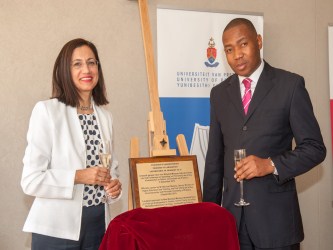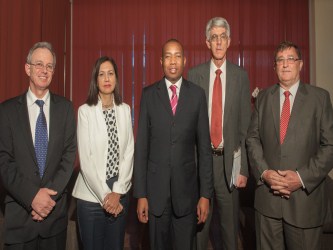Posted on September 12, 2013
The call to increase the number of medical students that are educated locally was made by the Minister of Health, Dr Aaron Motsoaledi and the Minister of Higher Education and Training, Dr Blade Nzimande. This followed the report by the Health Professions Council of South Africa that the national number of doctors qualifying annually over the past six years has remained steady at about 1 200 . Minister Motsoaledi said that South Africa could not go on producing the number it has been delivering over the past decades. He envisaged raising the number of new medical doctors to 3 600 a year.
The University of Pretoria is one of the medical universities that has responded to the call to increase the number of medical doctors who finish annually. However, to achieve this, more funding was needed to increase its infrastructure. This includes more laboratories, lecture halls and student residences.
The Ministry of Higher Education and Training has conceded that Veterinary Science is also a scarce skill in South Africa, and has therefore called for intervention to significantly expand the University of Pretoria’s Veterinary Science facilities, and to ensure that it increases its student intake to reflect the country’s social demographics. The Department of Higher Education and Training used its National Skills Fund to sponsor the extensions at the University of Pretoria’s Faculty of Health Sciences and Faculty of Veterinary Sciences.
Deputy Minister Manana said the Department of Higher Education and Training has invested in the projects to ensure that it increases its intake of the Bachelor of Veterinary Sciences (BVSc) programme. “The investment will result in an annual increase of 50 veterinary science students. That is a whopping 36% increase in the intake – from 120 to 190 first-year students. This increased capacity is important to the country”.
However, the Deputy Minister said it was also extremely important that the University immediately deal with the skewed equity profile of its student population in Veterinary Science, especially since it was the only facility producing professional veterinarians for the country. “We urge the university to implement processes that will transform the student profile in the veterinary programme to be more reflective of the country’s demographics”, he added.
The Dean of the Faculty of Veterinary Science at the University of Pretoria, Prof Gerry Swan, said the Faculty was committed to transformation. He said that for the first time, the faculty increased its numbers during the previous year, and at the student intake for the current year the number of African students entering into the BVSc programme has increased by 50%. “The progressive transformation of the faculty in terms of finally producing a number of graduates will take some time as the students are progressing through the system. We are taking this very seriously because it is not only important to us but it is also extremely important for the country”, said Prof Swan.
Prof Swan also said that the funding from the Department of Higher Education and Training has enabled the faculty to expand its existing infrastructure and facilities and also to establish community satellite facilities. “We were able to modify lecture rooms, and we will be building a multipurpose laboratory. A skills laboratory and student facilities that include residences that will be able to house up to 70% of students have also been built. Most importantly, this generous grant has enabled us to expand the hospital, and to provide satellite facilities”, said Prof Swan.
Regarding the expansion to the Faculty of Health Sciences at the University of Pretoria, Deputy Minister Manana further said that although the University has a limited space of 220 vacancies for medical students, the increase of facilities will provide opportunities for an additional 160 students annually. “While aimed primarily at enabling the increase in the intake of students into the MBChB programme, the new infrastructure development will also make it possible for the University to increase its intake into other health professional programmes such as the Health Care Science programmes and the Dental Medicine programme”, he said.
The Dean of the Faculty of Health Science, Prof Eric Buch, said that in response to the request by both the Ministries of Health and Higher Education and Training to have a substantial increase of medical doctors in the country, his faculty had felt committed to contribute to that goal despite the biggest challenge of a lack of facilities. However, this was now made possible by the grant the faculty received from the Department of Higher Education and Training’s National Skills Fund. “This grant will assist in the development of a 400-seater lecture theatre, skills laboratories and student administration at the Prinshof Campus. Student residences will also be expanded to accommodate the Health Science students in the vicinity of our campus.”
Prof Buch said that in the current year the intake of medical students increased to 300. More than 50% of these students and more than 60% of post-graduate students are African. He said the Faculty of Health Science has not changed its standards, and has a record of more than 90% students who finish the programme. “We really believe that we have become a home of first-choice for all South Africans, and our faculty has a very strong culture of teaching and learning. We also have very strong student support systems”, said Prof Buch.
The Vice-Chancellor and Principal of the University of Pretoria, Prof Cheryl de la Rey said the increased investment by the Department of Higher Education and Training at the University is a positive sign for the future of our country. She said the University is faced by the challenge of growing applications. This has resulted in a decision for the University to grow, as part of the University’s Strategic Plan, UP2025. “This was not an easy choice for us because to grow in the face of difficult economic circumstances could compromise the quality of our education. However, as the largest research-intensive university, we continue to grow in areas that are closely aligned with the national needs of our country”, she said.
Prof De la Rey said that as the University of Pretoria grows, the Department of Higher Education and Training has committed itself to assist the University in expanding its infrastructure to be able to accommodate the growing numbers of student enrolment. “The investment made by the Department of Higher Education and Training demonstrates that government believes in the future of the University of Pretoria,” she added.
Prof De la Rey said that the Faculties of Health Sciences and Veterinary Sciences represent two of the most sought-after fields by promising school leavers. With the opportunity of expanding its capacity, the University will be able to produce more professionals in health and veterinary science than it could do in the past. “I express our appreciation and gratitude to the Ministries of Higher Education and Training and Health. They have made a contribution by supporting our plan to enrol more students. We also thank our stake holders and partners who support both the faculties”, she concluded.

Prof Cheryl de la Rey revealing the plaque of the new IT laboratory building that has recently been completed.

From left to right are Prof Eric Buch (Dean of the Faculty of Health Sciences), Prof Cheryl de la Rey (Vice-Chancellor and Principal of the University of Pretoria) Mr Mduduzi Manana (Deputy Minister of Higher Education and Training) Prof Antony Melck (Executive Director of Institutional Planning) and Prof Gerry Swan (Dean of the Faculty of Veterinary Sciences).
Copyright © University of Pretoria 2025. All rights reserved.
Get Social With Us
Download the UP Mobile App